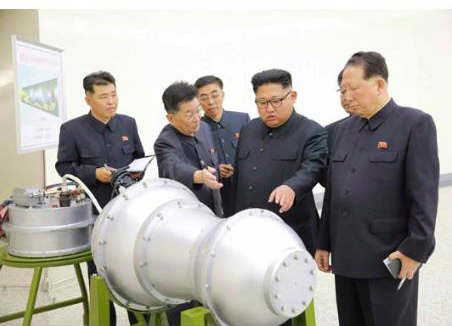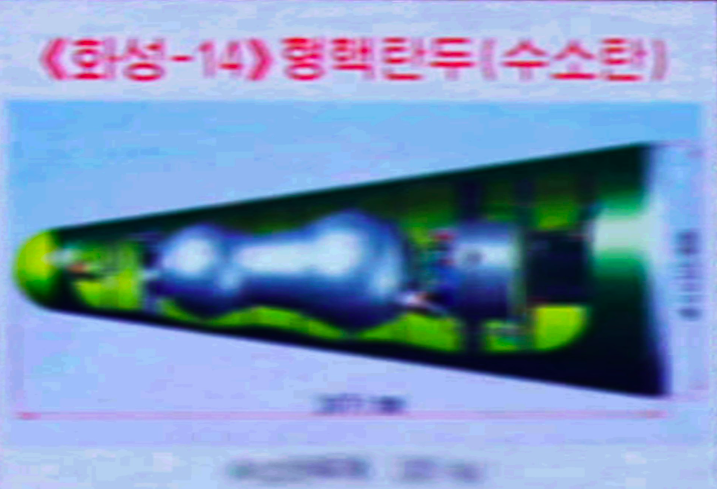Sixth Nuclear Test Detected at Punggye-ri, Declared to be a Hydrogen Bomb
At approximately 03:30 UTC (noon DPRK time) on September 3, 2017 North Korea’s Nuclear Weapons Institute conducted its largest and long-expected 6th nuclear weapons test from the Punggye-ri Nuclear Test Facility. Initial reporting from the US Geological Survey (USGS) first claimed the magnitude to be 5.2, but quickly upgraded the event to magnitude 6.3.[1] Other seismological agencies including the Comprehensive Test Ban Treaty Organization (CTBTO) and the independent Norwegian Research Organization (NORSAR) determined the magnitude to have been 5.8.[2] While multiple preliminary seismic readings will need to be refined over the upcoming days, if this lower number is correct, NORSAR calculated that the yield of the test device would be about 120 kilotons[3] (or about eight times the yield of the bomb dropped on Hiroshima in 1945, and about six times that of the 5th test conducted at Punggye-ri on September 9, 2016).
The official North Korean statement released claims that “the DPRK successfully carried out a test of H-bomb[4] for ICBM in the northern nuclear test ground of the DPRK at 12:00 on September 3…”[5] As a prelude to the event, Korean Central Television (KCTV) posted images the day before the test of Kim Jong Un visiting the “Nuclear Weapons Institute” to see what was described as a two-stage hydrogen warhead for the Hwasong-14 inter-continental ballistic missile (ICBM). That announcement claimed that the warhead was designed to have a variable yield, “the explosive power of which is adjustable from tens kiloton to hundreds kiloton, is a multi-functional thermonuclear nuke with great destructive power which can be detonated even at high altitudes for super-powerful EMP attack according to strategic goals.”[6]
The released photographs purportedly show Kim Jong Un providing “guidance” on what the North Korean press called a “thermonuclear” warhead for a ballistic missile. The device shown in the images has many of the hallmarks of such a device (two bulbous ends shaped like a peanut consistent with the claim of a “two-stage” device); however, caution should be taken as this is the conclusion that North Korea wants the US and others to reach from viewing the images and it is likely that an actual device will have a somewhat different design and that this was only a model mock-up.


It should be noted that another seismic event, magnitude 4.6, was detected exactly 8.5 minutes after the noon event. Among the possibilities for such an event the USGS proffered that it was a post-test “tunnel collapse,”[7] but it could also have been a “chimney collapse” caused by the area above the test cavity collapsing downward forming an upward shifting cavity known as a chimney. Another possibility is that it was a landslide or other earth movement induced by the large test (or perhaps, less likely, some type of small, as yet unidentified, explosive event). Such a post-test event of this magnitude increases the likelihood of a radionuclide gas release, which, if detected by the CTBTO and others, might help to establish more specific device parameters.[8]
We are in the process of procuring post-test imagery to determine the full extent of the observable surface effects of this, the largest, underground nuclear test conducted by the DPRK to date.
Implications
This most recent test, likely involving some form of fission-fusion (“thermonuclear”) reaction, but not necessarily a two-stage device, will undoubtedly provide North Korea with extremely valuable scientific and technical data that will allow them to refine their computer models, improve weapons design and validate engineering, as described in the Nuclear Weapons Institute statement,
“The result of the experimental measurements showed that the power specifications of nuclear warhead including total explosion power and fission to fusion power rate and all other physical specifications reflecting the qualitative level of two-stage thermo-nuclear weapon fully complied with design figures.”
Regardless of whether this most recent test was an operational warhead for an ICBM or simply a device, the yield of the test clearly shows North Korean progress in increasing the yields of the nuclear weapons. The significance of this is that it has the potential to dramatically increase the threat posed by its Strategic Force (responsible for ballistic missiles) as individual nuclear warheads potentially now have 10-times-greater destructive power. This would allow fewer missiles to be employed to ensure destruction of a given target, and increase the target set threatened by North Korean ICBMs by allowing a larger number of targets to be engaged with the current missile inventory. If the claim that the device just tested has a variable yield is true (from tens to hundreds of kilotons), then this would also imply a more sophisticated employment doctrine that envisions more limited, flexible and discrete targeting options than would otherwise be needed to implement a minimum deterrence, counter value doctrine.
- [1]
“M 6.3 Explosion – 22km ENE of Sungjibaegam, North Korea” US Geological survey, September 3, 2017, https://earthquake.usgs.gov/earthquakes/eventpage/us2000aert#executive.
- [2]
https://twitter.com/SinaZerbo/status/904206338099748866 and “Large nuclear test in North Korea on 3 September 2017,” NORSAR, September 3, 2017, https://www.norsar.no/press/latest-press-release/archive/large-nuclear-test-in-north-korea-on-3-september-2017-article1534-984.html.
- [3]
A kiloton is equivalent to 1,000 tons of TNT. A megaton is equivalent to 1 million tons of TNT.
- [4]
The use of the terms “hydrogen bomb” or “H-bomb” by North Korea may, in fact, be referring to a hybrid of a fission and a fusion warhead, which can also be described as “boosted.”
- [5]
Dagyum Ji and Oliver Hotham, “North Korea announces successful test of hydrogen bomb,” September 3, 2017, NK News, https://www.nknews.org/2017/09/north-korea-announces-successful-test-of-hydrogen-bomb/?c=1504422580020.
- [6]
“Kim Jong Un Gives Guidance to Nuclear Weaponization,” KCNA Watch, September 3, 2017, https://kcnawatch.co/newstream/1504389746-780050885/kim-jong-un-gives-guidance-to-nuclear-weaponization/.
- [7]
“M 6.3 Explosion – 22km ENE of Sungjibaegam, North Korea,” US Geological survey, September 3, 2017, https://earthquake.usgs.gov/earthquakes/eventpage/us2000aetk#executive.
- [8]
“Radionuclide Monitoring,” Preparatory Commision for the Comprehensive Nuclear-Test-Ban Treaty Organization, https://www.ctbto.org/verification-regime/monitoring-technologies-how-they-work/radionuclide-monitoring/.
